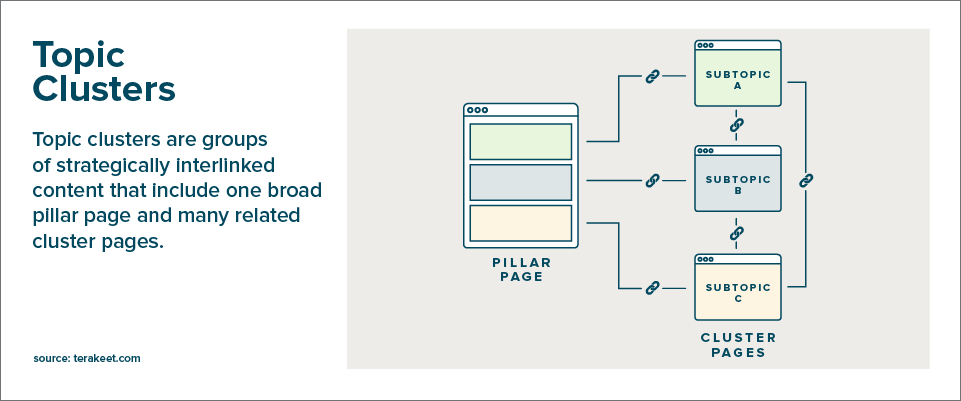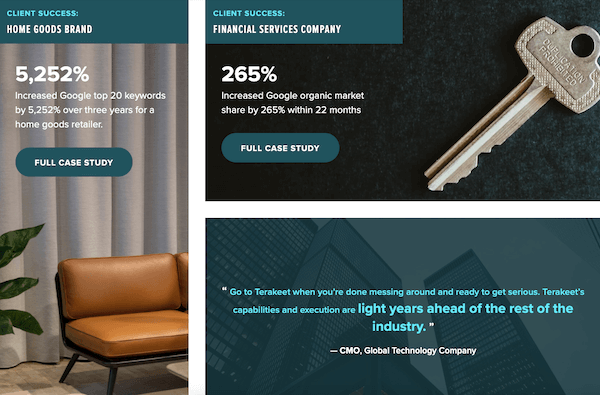
13 Types of Content Marketing Formats You Need to Use Now
Nov 5, 2021|Read time: 15 min.
Key Points
- Understand the different types of content marketing to create a cohesive content marketing strategy.
- Use different forms of content to achieve different marketing objectives.
- Repurpose your content in multiple formats to reach a broader audience more efficiently.
If you ask 10 different marketing teams about their favorite types of content marketing, you’ll have 10 completely different conversations.
One marketer may talk about their awesome YouTube series. Another might discuss SEO topic cluster strategies. And another may gush about how they partnered with influential bloggers to create visual content campaigns for Instagram and Snapchat.
That’s because the phrase “content marketing” is often used as a catch-all definition for all the ways you promote your content strategy.
But, the reality is that there are numerous content marketing formats and each one has its own unique benefits. Knowing the different types of content marketing is important, because it gives you more options in your digital marketing toolbox. Moreover, it’s crucial to understand how to use each one effectively to create a cohesive overall content marketing strategy.
Read on to learn the different types of content marketing and how to use each one to boost your ROI.
The different types of content marketing
Each piece of content you produce should have a defined purpose. Some examples include, education, inspiration, utility, persuasion, entertainment, or sales.
Furthermore, there are many different formats to consider. Here’s a short list of the most popular types of content marketing:
- Blogging
- Case studies
- Success stories
- Customer testimonials
- Online reviews
- White papers & ebooks
- Templates
- Videos
- Infographics
- Podcasts
- Webinars
- Interactive content
- Social media
- User-generated content
- GIFs and memes
When thinking about various content marketing examples, remember that people learn in a variety of ways. Different types of content appeal to different segments within your audience. Some are auditory learners and are attracted to podcasts. Others are visual learners and prefer videos, infographics, or presentations. And yet others prefer text, such as blog posts, white papers, or reports.
So, by leveraging multiple types of content in digital marketing, you can appeal to a variety of learners.
There is no “best” type of content marketing
Some content marketing types support an inbound marketing methodology. Other formats can be an important component of an account-based marketing (ABM) initiative. Similarly, certain content naturally supports your sales team.
Additionally, some types of content are better suited for particular stages in the customer journey than others. For example, blog posts, articles, and video can be an excellent way of connecting with those in the awareness stage of the journey. White papers, ebooks, and webinars are often a good fit for the middle stage of the buying process. And case studies, success stories, and ROI calculators can be the clincher when it comes to overcoming objections and convincing a prospect to become a customer.
Leveraging different forms of content allows you to speak to prospects no matter where they are in their journey.
Benefits of using different types of content marketing
Companies and brands can experience a range of benefits from content marketing, including:
- Expanding reach and brand awareness
- Grabbing attention
- Establishing thought leadership
- Driving traffic
- Building trust
- Deepening relationships
- Generating social shares and backlinks
- Increasing sales
Each kind of content brings unique benefits. A robust content strategy template should include various content types that will serve different purposes.
Content Strategy Playbook
The Fortune 500 CMO’s guide to content strategy.
1. Blogs
Blog content is an outstanding way to build your brand and increase traffic to your website. A well-organized blog strategy keeps you focused on the keywords and topics your target audience cares about. Long-form content is the perfect way to address pain points, answer questions, and establish authority in your space.
Optimized, high-quality blog posts can also perform well in the search engines, giving a boost to your SEO. Long-form content tends to be a more evergreen type of content marketing compared to many other formats. So, the content you publish today can continue to drive traffic and leads for years. Compare this to social media posts, which can get buried in newsfeeds after a few hours.
Another benefit of blogging is that it emphasizes your brand personality. If your brand is innovative, intelligent, or funny, blogging gives you plenty of runway to showcase your unique personality.
2. Case studies and success stories
Case studies and success stories are a prime example of conversion-driven content marketing. They’re an extremely effective way to generate leads in the bottom of the conversion funnel. When prospects read about similar customers who have had positive experiences with your organization, it provides them with social proof and makes their purchase decision easier.
In other words, they feel like you’ve done this before, so they can expect similar results.
Case studies are especially important for higher-cost, higher-value products and services. This type of content emphasizes marketing ROI and reduces the risk of a large investment. The examples to the right come from Terakeet’s customer success page.
3. Testimonials and online customer reviews
Testimonials and customer reviews are a different form of content marketing that leverages social proof. They’re especially useful in helping your brand overcome potential objections from prospects and reducing their feeling of risk. Additionally, online reviews on third-party sites like Google, Angi, or Trustpilot also serve as a valuable off-page SEO signal.
When Google sees a large number of positive reviews associated with your brand, it indicates to them that your brand is trustworthy and your website should be ranked higher in search results than brands with fewer positive reviews.
Some simple ways to increase the number of reviews and testimonials you get include:
- Directly ask existing customers
- Create an automated follow-up request that is sent to customers after they purchase from you
- Incentivize customers with a discount or other reward for sharing their opinion
- Add a review/testimonials widget to your website home page and other key pages so that visitors can quickly leave feedback without ever leaving your site
Prominently display testimonials and reviews on your home page, as well as on any other relevant pages of your website. A power tip is to place testimonials and reviews where they would be most contextually relevant to what’s on a given page.
Here’s an example of a testimonial from our homepage:

4. White papers and ebooks
White papers and ebooks are a great way to build thought leadership, gain credibility in your industry, generate leads, and position yourself as an expert. They are usually longer and more technical than blog posts. This allows you to thoroughly explore a particular subject and share more granular information beyond what you would typically be able to do in a blog post.
Create white papers and ebooks when you have especially deep knowledge or differentiation in a specific topic area. With white papers and ebooks, it’s important to share quality content that delivers on the value they expect when taking the time to download your content.
This type of content marketing strategy tends to work particularly well toward the middle/bottom of the funnel. During this stage, you need to further educate prospects on the problem they’re facing, the solution you offer, and why you’re a better choice than a competitor.
For example, here’s one of our white papers about enterprise SEO:
5. Market reports
Market reports are an incredibly effective way to capture media attention and position your brand as a thought leader within your industry. This type of content marketing targets decision makers who need access to broad market data in order to build their strategy.
Reports can focus on market share, spending, trends, technology, consumer behavior, or any number of other factors.
What makes them particularly powerful is their ability to drive high-value media mentions, backlinks and leads (assuming you gate the report).
Below is an example of one of Terakeet’s recent reports from the beauty industry. We leveraged our internal technology to calculate the market share of the top performing websites within the cosmetics industry. Then, we published a report, a high-level blog post, and a deep dive case study about one of the top performing websites.
Beauty Market Report
See which beauty brands are winning, and losing, in the race for market share.
6. Videos
In recent years, video content has become increasingly important as a content marketing strategy.
- Videos help to attract 300% more traffic. (Source: MarketingSherpa)
- Video has helped generate leads for 83% of video marketers. (Source: Wyzowl)
- Watching a brand’s video has convinced 84% of people to purchase a product or service. (Source: Wyzowl)
- 68% of marketers say video has a better return on investment than Google Ads. (Source: Biteable)
- 88% of video marketers reported that video gives them a positive ROI. (Source: Wyzowl)
Video content is effective because it allows you to connect with your target audience in a visual, engaging way that isn’t possible through many other types of content. For example:
- Short explainer videos that are 60 seconds or less serve as a quick, simple way to quickly educate prospects on a topic
- How-to videos help customers understand how to solve a very specific problem
- Demo videos can help customers quickly see the capabilities of your product
- Interviews enable your customers to see the human side of your business. And Customer interviews get them to see what they themselves could achieve.
- Long-form videos can tell a story in a way that connects emotionally with the audience
- Quick social media clips attract attention and drive engagement
7. Infographics
Infographics allow you to present a significant amount of information quickly and clearly, including business, industry, or SEO statistics, maps, events, timelines, etc. They can function as standalone pieces of content that can be shared on social media platforms. Alternatively, they can act as a supplement to written content, like a blog post or a white paper.
In addition to being visually engaging, infographics are well-suited for social media marketing efforts, and particularly interesting ones tend to get shared widely.
Additionally, if you feature an infographic on a page on your website, you can easily create a small snippet of HTML code that allows others to embed the infographic on their sites. The HTML can be coded so that every time someone embeds the image on a website, a backlink to your website is automatically included as part of the description. The more people embed the infographic the more backlinks you get, which benefits your SEO.
And graphics don’t need to be massive to be effective. Sometimes micrographics work even better. Here’s an example of one we create to help illustrate the concept of topic clusters:

8. Podcasts
Podcasting is becoming an increasingly effective form of content marketing and brand building. One of its biggest advantages is that it allows you to offer long-form, high-value information without investing an exorbitant amount of time or effort. It allows you to share your expertise and stories with your audience directly. It helps you build relationships with your potential customers by connecting with them on a more personal level.
Another major benefit of podcasts is that they are portable. They are easy to listen to during a work commute or during a cardio workout when reading may not be an option.
If you interview guests on your podcast, you enjoy the added benefit of potentially using your podcast as a lead generation engine. You can invite representatives from the companies you most want to do business with, and feature them as a way to 1) generate podcast content and 2) build a relationship with a new lead.
Drift started podcasting early in its history, recognizing that it was a great format for them to discuss conversational marketing, which is central to their brand. Over time, they created nine separate podcasts to serve new audience segments. This strategy helped them to eventually achieve a billion-dollar valuation with an army of passionate fans.
9. Webinars
Webinars are an excellent content marketing tool to educate your prospects and customers and position your brand as an industry or subject matter authority. The visual format makes them perfect for illustrating how to get the most out of your product or how to overcome a particular problem. Most webinars tend to be on the longer side (30+ minutes), since they contain a strong educational element.
You can also use webinars to partner with prospects. As a result, you’ll generate unique content while building a relationship with a new lead.
Another key benefit of webinars is the live interaction between the presenter and the viewers. Viewers can ask questions and the presenter can respond to them in real time. This creates a more personal connection than more static forms of content.
The main downside to this type of content marketing is the amount of work you’ll need to do. You’ll need the right software, environment, and hardware, as well as a clear strategy.
Checkout the webinar below that I hosted with Clearscope about topic clusters and keyword grouping:
10. Interactive content
Interactive content like quizzes, assessments, checklists, apps, tools, or games can be used to engage with your target audience while also collecting valuable information. For example, mattress company Helix has an interactive “Sleep Quiz” designed to help potential buyers find the perfect mattress based on their sleep preferences. And, of course, to receive the results of the quiz, you need to supply your email address, which Helix can use to further market their products to you.
You can use similar types of interactive content to capture new leads, receive customer feedback, boost retention and engagement, or build an initial audience for further retargeting. And of course, you always have the option to simply entertain them.
One added benefit of interactive content is that it can attract a large number of inbound links. For example, HubSpot’s tool to build personas has attracted more than 15,000 backlinks from approximately 3,300 websites.
11. Social media
With billions of active users every month, social media may be a key tool in your content marketing arsenal. The main benefit of social media is direct engagement with your audience. It’s a real-time feedback loop to help you understand what your audience cares about, and to have direct conversations with them to dig deeper.
For certain brands, social media can also be used to guide your audience to sales, promotions, and events. In addition, social marketing gives you a direct path to distribute your content to your audience, and to express your brand personality in the process.
To effectively manage your social media, you’ll need to know your audience’s preferred platforms, as well as the types of posts they find valuable. For example, if you run an ecommerce store that sells rock climbing gear and your primary audience is Millennials and younger, you might focus primarily on adventure-filled posts on Instagram and TikTok. If you’re instead targeting people in their 50’s looking to get serious about a retirement plan, you might do better with YouTube videos or Facebook posts that link to long-form, text-based content.
For an added boost to your social media marketing performance, try building a relationship with a number of influencers in your space. Influencers can have very loyal audiences and communities which can help amplify the impact of your content.
12. User-generated content
Few content marketing options drive engagement like user generated content (UGC). UGC is content published by your customers that features your brand in some way. For example, this might include someone posting a selfie while using your product or tagging your brand in a post. It might be a customer taking a YouTube video, recording a product unboxing event. Or it could be your audience posting photos in response to a competition your brand is running.
UGC is so effective because it leverages both word of mouth (WOM) marketing as well as social proof. After all, prospects are far more likely to trust other consumers than your marketing material. And when someone likes your product and engages in UGC, they’ll probably tell all their friends about it, as well, accelerating your brand reach.
“
UGC can also engender real brand love because you’re giving them credit for their brand association.
TERAKEET
There are a number of ways you can encourage UGC:
- Invite customers to submit content and offer rewards for the best entries
- Use a social media hashtag around your brand or specific products and offer incentives to customers if they use that hashtag
- Collaborate with bloggers to feature UGC, or create your own content hub
- Regularly post UGC on your own social media feeds
13. Marketing templates
Does your business rely on demand generation to build a lead pipeline? Then downloadable templates could be your trojan horse. These can be as simple as an email template or a blog post framework, or as complex as a tool to research and build out buyer personas like the one below.
Buyer Persona Template
Build better buyer personas to meet your consumers’ needs.
Templates are one of the best types of content for marketing to B2B teams because they provide value for free. Then, after you collect a user’s contact information, you can leverage marketing automation tools to nurture them through email sequences.
Repurpose different content marketing types for greater ROI
Repurposing content in a variety of formats can save you time, enable you to reach more audience members, and achieve a higher content marketing ROI.
For example, if you publish a long-form blog post, you can extract individual stand-alone quotes and publish those across your social media profiles. You can also create a few videos that go into more depth on the points made in the post. You could then embed the videos in the post while also posting to YouTube and social media. In this way, your content gains greater mileage for your brand.
To achieve greater reach with your content, use a base piece of content as your main source, and then customize 10% of it in order to appeal to different verticals or other segments of your market.
And don’t let your old content go to waste either. Update stale, thin content so that it’s relevant and valuable to your audience today.
By repurposing your content in multiple formats, you can reach a much larger audience without needing to start from scratch with each piece of content.
Long-term thinking, long term rewards
When choosing the best content marketing types for your digital marketing campaigns, it’s tempting to take the path of least resistance. But, while you certainly need to consider what you can realistically create, it’s always better to have a long-term mindset.
Start with your goals and success metrics, and then work backwards to develop a step-by-step plan to get there.
Valuable content such as a well-researched blog post combined with a landing page to download your new template requires more resources to create than a few social media posts on LinkedIn. But, if you run that article through the right on-page optimization process, it can generate organic website traffic for years to come. On the other hand, those social media posts will be forgotten in a few hours regardless of how shareable they are.
Start with the types of content marketing formats that make sense for your audience, but prioritize long-term growth marketing over short-term gains. Do what it takes to invest in creating great content even though you may not see immediate results.
Playing the long game with content marketing takes a lot of patience, but once you start to see traction, you’ll likely see compound results over the long-term. That can have a massive impact on your business.





